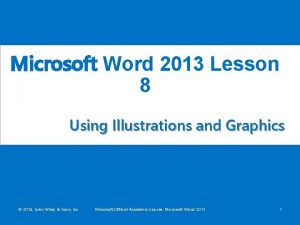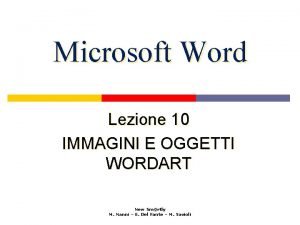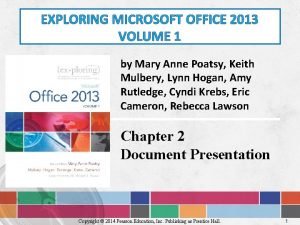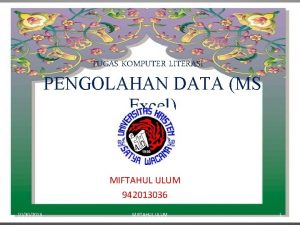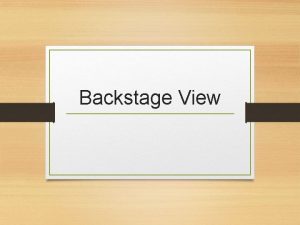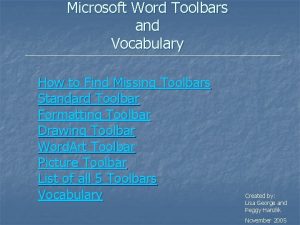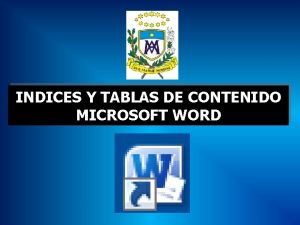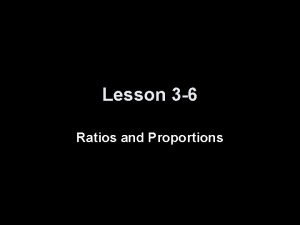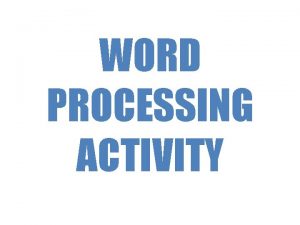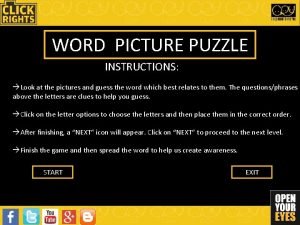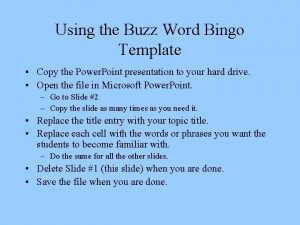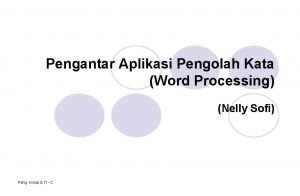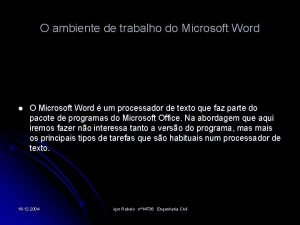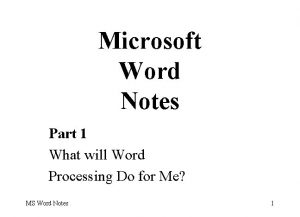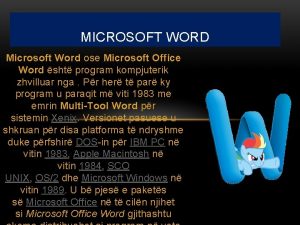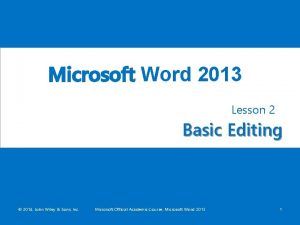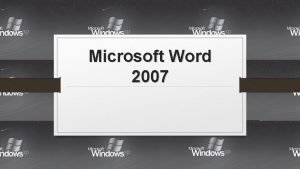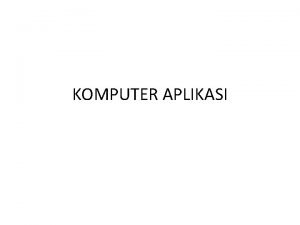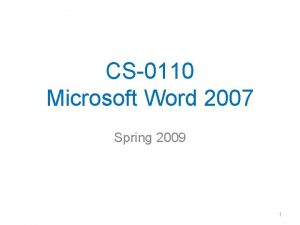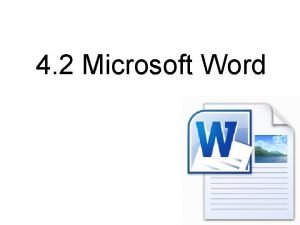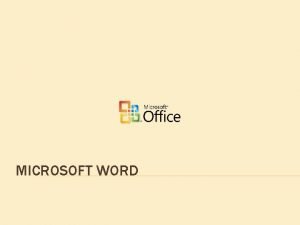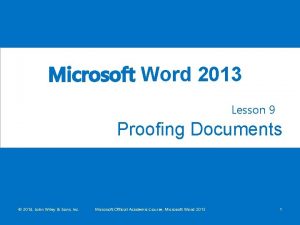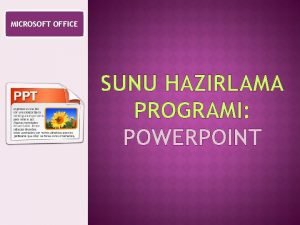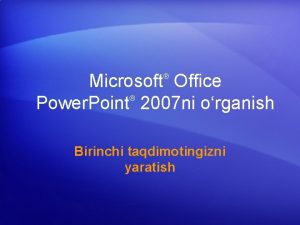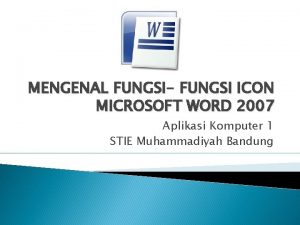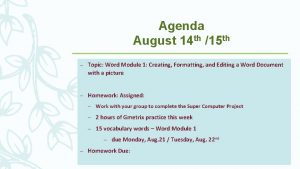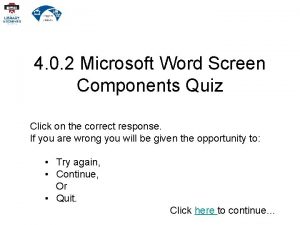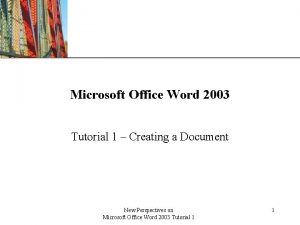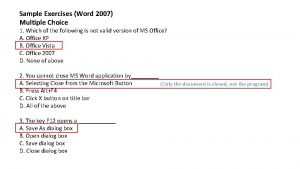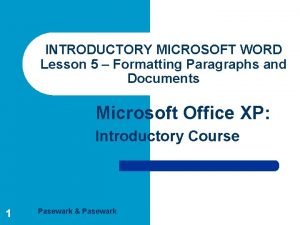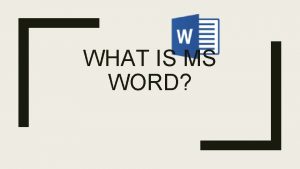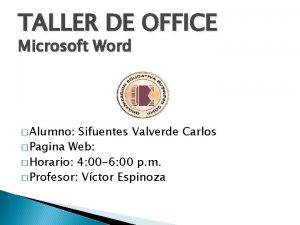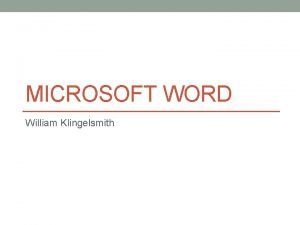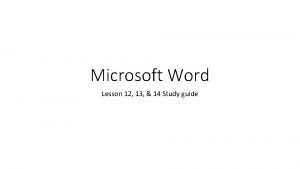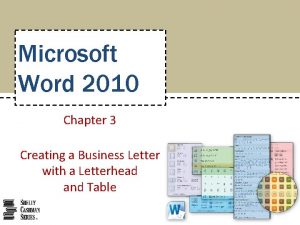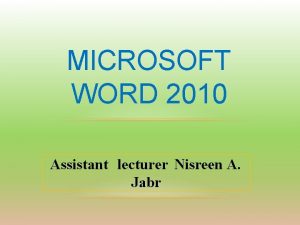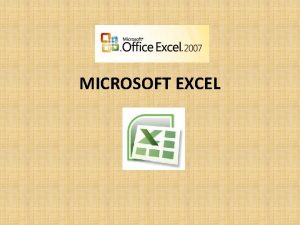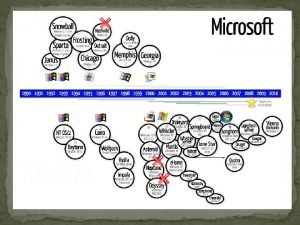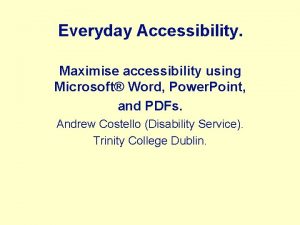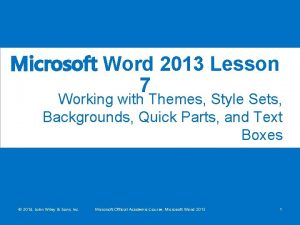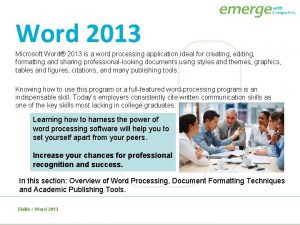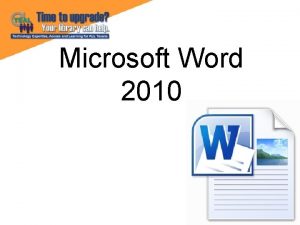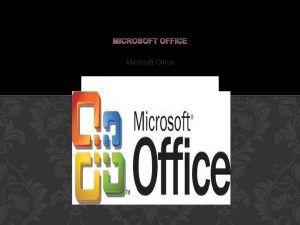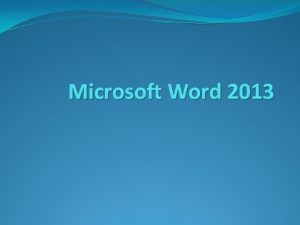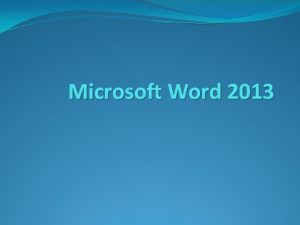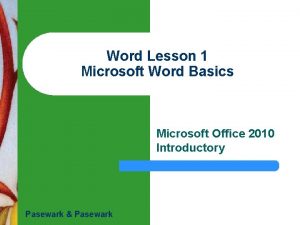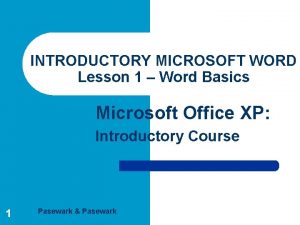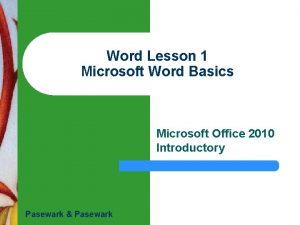Microsoft Word 2013 Lesson 7 Working with Themes










































































- Slides: 74

Microsoft Word 2013 Lesson 7 Working with Themes, Style Sets, Backgrounds, Quick Parts, and Text Boxes © 2014, John Wiley & Sons, Inc. Microsoft Official Academic Course, Microsoft Word 2013 1

Objectives © 2014, John Wiley & Sons, Inc. Microsoft Official Academic Course, Microsoft Word 2013 2

Step by Step: Format a Document with a Theme • OPEN the Hosting document from the data files for this lesson. 1. On the Design tab, in the Document Formatting group, click Themes; the Themes menu opens, as shown at right. 2. This document has already been preformatted with styles. © 2014, John Wiley & Sons, Inc. Microsoft Official Academic Course, Microsoft Word 2013 3

Step by Step: Format a Document with a Theme 3. Place your insertion point over any built-in theme and notice that the document changes to display a live preview of your document. 4. Click the View theme and the elements are applied to the document. Scroll down and view the changes in the document. 5. SAVE document as Hosting Term in the lesson folder on your flash drive. • PAUSE. LEAVE the document open to use in the next exercise. © 2014, John Wiley & Sons, Inc. Microsoft Official Academic Course, Microsoft Word 2013 4

Step by Step: Create and Customize a Document Color • USE the document that is open from the previous exercise. 1. In the Document Formatting group, click the Colors button to open the Colors menu (right). The Colors menu contains predefined formatting colors with four text and background colors, six accent colors, and two hyperlink colors. These colors can be customized and saved with a new name. © 2014, John Wiley & Sons, Inc. Microsoft Official Academic Course, Microsoft Word 2013 5

Step by Step: Create and Customize a Document Color 2. At the bottom of the Colors menu, click Customize Colors; the Create New Theme Colors dialog box opens (right). 3. In the Name box, replace Custom 1 by typing Corporate [your initials]. 4. Click Save; the dialog box closes and you have defined a new custom theme color name based on default colors. © 2014, John Wiley & Sons, Inc. Microsoft Official Academic Course, Microsoft Word 2013 6

Step by Step: Create and Customize a Document Color 5. Click Colors and under the Custom section, place your insertion point over Corporate [your initials]. Right-click theme name, and then click Edit from the pop-up menu that appears. The Edit Theme Colors dialog box appears. 6. Another Way: You can edit the Colors and Fonts in the Styles group, under Styles or use the shortcut keys, ALT+CTRL+SHIFT+S. 7. In the list of theme colors, click the Accent 2 drop-down arrow to produce a menu of colors for this element. © 2014, John Wiley & Sons, Inc. Microsoft Official Academic Course, Microsoft Word 2013 7

Step by Step: Create and Customize a Document Color 8. Select Tan, Text 2, Darker 50%. 9. Click Save. You changed the default color to a specific color and created your own custom theme colors for your document. 10. SAVE the document in the lesson folder on your flash drive. • PAUSE. LEAVE the document open to use in the next exercise. © 2014, John Wiley & Sons, Inc. Microsoft Official Academic Course, Microsoft Word 2013 8

Step by Step: Create and Customize a Document Font • USE the document that is open from the previous exercise. 1. Click the Fonts button to produce the Fonts menu (right). In the menu, click Customize Fonts; the Create New Theme Fonts dialog box opens. 2. In the Name box, replace Custom 1 by typing Corporate Fonts [your initials]. 3. Change the Heading Font and Body Font to Arial. Notice the preview of your font choices that appears in the Sample pane of the dialog box. © 2014, John Wiley & Sons, Inc. Microsoft Official Academic Course, Microsoft Word 2013 9

Step by Step: Create and Customize a Document Font 4. Click Save to close the dialog box and apply your font choices to the document. 5. SAVE the document in the lesson folder on your flash drive. • PAUSE. LEAVE the document open to use in the next exercise. © 2014, John Wiley & Sons, Inc. Microsoft Official Academic Course, Microsoft Word 2013 10

Step by Step: Create and Customize Document Effects • USE the document that is open from the previous exercise. 1. Position the insertion point anywhere in the document. 2. Click the Effects button and select Glossy from the menu that appears (right). © 2014, John Wiley & Sons, Inc. Microsoft Official Academic Course, Microsoft Word 2013 11

Step by Step: Create and Customize Document Effects • When applying shapes to your document, such as a bevel shape, the shape displays based on the effect you selected. Notice the change in the bevel shape on page 1 next to the second paragraph under the heading Introduction (below). 3. SAVE the document as Hosting Term 1 in your flash drive in the lesson folder. • PAUSE. LEAVE the document open to use in the next exercise. © 2014, John Wiley & Sons, Inc. Microsoft Official Academic Course, Microsoft Word 2013 12

Step by Step: Apply Paragraph Spacing • USE the document that is open from the previous exercise. 1. Position the insertion point anywhere in the first paragraph. In the Document Formatting group, click the Paragraph Spacing button. © 2014, John Wiley & Sons, Inc. Microsoft Official Academic Course, Microsoft Word 2013 13

Step by Step: Apply Paragraph Spacing 2. The built-in menu appears (right). 3. Hover each of the builtin settings and notice the changes on the whole document. Also, a Screen. Tip appears displaying the line and paragraph setting for that option. Select Open. 4. SAVE the document as Hosting Term 2 in your flash drive in the lesson folder. • PAUSE. LEAVE the document open to use in the next exercise. © 2014, John Wiley & Sons, Inc. Microsoft Official Academic Course, Microsoft Word 2013 14

Step by Step: Apply a Style Set to a Document • USE the document that is open from the previous exercise. 1. Hover the mouse over a few of the built-in Style Sets in the Document Formatting group and watch how the appearance of the document changes. Note, before applying Style Sets, the document must contain styles. © 2014, John Wiley & Sons, Inc. Microsoft Official Academic Course, Microsoft Word 2013 15

Step by Step: Apply a Style Set to a Document 1. Click the More button and select Traditional as shown below. 2. SAVE the document as Hosting Term 3 in your flash drive in the lesson folder, and then CLOSE the file. • PAUSE. LEAVE the document open to use in the next exercise. © 2014, John Wiley & Sons, Inc. Microsoft Official Academic Course, Microsoft Word 2013 16

Step by Step: Insert a Page Color • OPEN Hosting from your flash drive for this lesson. 1. Click the Design tab. 2. In the Page Background group, click the Page Color button to open the color menu and gallery (right). 3. Click to select White, Background 1, Darker 5%; the page color is applied. 4. SAVE the document as Hosting Term 4 in your flash drive in the lesson folder. • PAUSE. LEAVE the document open to use in the next exercise. © 2014, John Wiley & Sons, Inc. Microsoft Official Academic Course, Microsoft Word 2013 17

Step by Step: Format the Page Color Background • USE the document that is open from the previous exercise. 1. With the Design tab active, click the Page Color button, to display the menu. 2. Click Fill Effects. The Fill Effects dialog box opens with the Gradient tab active. 3. Under the Colors section, select Preset. 4. Click the drop-down arrow under the Preset colors section to view available background colors in the Sample area. 5. In the Gradient tab under the Colors section, change your selection to Two colors. Two options appear, Color 1 and Color 2. © 2014, John Wiley & Sons, Inc. Microsoft Official Academic Course, Microsoft Word 2013 18

Step by Step: Format the Page Color Background 6. 7. Under Color 2, click the dropdown arrow to produce the color palette. Select Black, Text 1, Lighter 50%. The selected color appears in the box under Color 2 (right). Under the Variants section, samples of the two colors are displayed. Under the Shading Styles section, you have choices on how the style should appear in the document. Select From Center. Notice the lower-right corner produces the Color 1 in the Center and Color 2 outside. Click OK. © 2014, John Wiley & Sons, Inc. Microsoft Official Academic Course, Microsoft Word 2013 19

Step by Step: Format the Page Color Background 8. SAVE the document as Hosting Term 5 in the lesson folder on your flash drive. • PAUSE. LEAVE the document open to use in the next exercise. © 2014, John Wiley & Sons, Inc. Microsoft Official Academic Course, Microsoft Word 2013 20

Step by Step: Insert a Watermark • USE the document that is open from the previous exercise. 1. In the Page Background group of the Design tab, click the Watermark menu and select Confidential 1. 2. The watermark is placed behind the text and is transparent. 3. SAVE the document with the same filename in the lesson folder on your flash drive. • PAUSE. LEAVE the document open to use in the next exercise. © 2014, John Wiley & Sons, Inc. Microsoft Official Academic Course, Microsoft Word 2013 21

Step by Step: Insert a Custom Watermark • USE the document that is open from the previous exercise. 1. Click the Watermark menu and select Custom Watermark. The Printed Watermark dialog box opens. 2. Select the Text watermark radio button and then click the drop-down arrow next to Text and select Draft. You can customize text watermarks by typing content in the text box or you can select from the drop-down menu. 3. Click the drop-down arrow by Font and select Franklin Gothic Book. This changes the text watermark font. © 2014, John Wiley & Sons, Inc. Microsoft Official Academic Course, Microsoft Word 2013 22

Step by Step: Insert a Custom Watermark 4. In the Color box, click the dropdown arrow and select Dark Red in the Standard Colors box (right). 5. Click OK. The watermark is inserted on all pages. If you click Apply, the dialog box remains open and you can view your watermark in the document. When you click OK, the dialog box closes and you’re back in the document screen. 6. SAVE the document as Hosting Draft in the lesson folder on your flash drive. • PAUSE. LEAVE the document open to use in the next exercise. © 2014, John Wiley & Sons, Inc. Microsoft Official Academic Course, Microsoft Word 2013 23

Step by Step: Insert an Image Watermark • USE the document that is open from the previous exercise. 1. Remove the Page Color background, by clicking the Page Color button, and then selecting No Color. The background is removed. 2. Click the Watermark menu and select Custom Watermark. The Printed Watermark dialog box opens. 3. Select the Picture watermark radio button and then click the Select Picture button. © 2014, John Wiley & Sons, Inc. Microsoft Official Academic Course, Microsoft Word 2013 24

Step by Step: Insert an Image Watermark 4. Click the Browse button from Select from File, and then locate your lesson folder and select Internet Search. 5. Click Insert to insert the image in the document, and then click OK to close the Printed Watermark dialog box. 6. SAVE the document as Hosting with Image in the lesson folder on your flash drive. • PAUSE. LEAVE the document open to use in the next exercise. © 2014, John Wiley & Sons, Inc. Microsoft Official Academic Course, Microsoft Word 2013 25

Step by Step: Remove a Watermark • USE the document that is open from the previous exercise. 1. Open the Watermark menu and select Remove Watermark. The watermark is removed from the document. 2. Click the Undo button. 3. SAVE the document in the lesson folder on your flash drive, and then CLOSE the file. • PAUSE. LEAVE Word open for the next exercise. © 2014, John Wiley & Sons, Inc. Microsoft Official Academic Course, Microsoft Word 2013 26

Step by Step: Add a Page Border • OPEN the Hosting Term 5 document from the lesson folder. 1. In the Page Background group of the Design tab, click the Page Borders button. The Borders and Shading dialog box appears with Page Border as the active tab. 2. In the Setting section, click the Shadow option. Notice the Preview area on lower-bottom right side has a shadow effect to the border. 3. Click the drop-down arrow on the Color menu and choose Black Text 1, Lighter 5%. You apply a specific color to the border. 4. Click the drop-down arrow on the Width menu and choose 2 1/4 pt. The width of the border is increased to provide emphasis. © 2014, John Wiley & Sons, Inc. Microsoft Official Academic Course, Microsoft Word 2013 27

Step by Step: Add a Page Border 5. Click the drop-down arrow on the Apply To menu and click This Section–First Page Only as shown below. The page border is applied only to the first page of this section. © 2014, John Wiley & Sons, Inc. Microsoft Official Academic Course, Microsoft Word 2013 28

Step by Step: Add a Page Border 6. Click OK. Scroll and review your document, and notice that the border does not appear on other pages. 7. Select the bevel shape on page 1 and press Delete. Hint: you need to see a solid border to delete the shape. 8. SAVE the document as Hosting Term 6 in the lesson folder on your flash drive. • PAUSE. LEAVE the document open to use in the next exercise. © 2014, John Wiley & Sons, Inc. Microsoft Official Academic Course, Microsoft Word 2013 29

Step by Step: Use Built-In Building Blocks • USE the document that is open from the previous exercise. 1. On the Insert tab, in the Text group, click the Quick Parts button to display the Quick Parts menu, as shown below. © 2014, John Wiley & Sons, Inc. Microsoft Official Academic Course, Microsoft Word 2013 30

Step by Step: Use Built-In Building Blocks 2. Click the Building Blocks Organizer menu option to display the Building Blocks Organizer dialog box, as shown below. 3. Click the Name heading to sort the Building Blocks by name. © 2014, John Wiley & Sons, Inc. Microsoft Official Academic Course, Microsoft Word 2013 31

Step by Step: Use Built-In Building Blocks 4. Scroll down the list and select Confidential 1 Watermark. 5. Click the Insert button. The Confidential watermark appears behind the text on every page. 6. Display the Building Blocks Organizer dialog box. 7. Click the Gallery heading to sort the Building Blocks by gallery. © 2014, John Wiley & Sons, Inc. Microsoft Official Academic Course, Microsoft Word 2013 32

Step by Step: Use Built-In Building Blocks 8. Position the insertion point at the beginning of the first paragraph under Introduction. 9. Scroll down and select Austin Pull Quote from the Text Box gallery. Click Insert and a pull quote is inserted in the document as shown below. You can type text in the placeholders or drag and drop text in the area. © 2014, John Wiley & Sons, Inc. Microsoft Official Academic Course, Microsoft Word 2013 33

Step by Step: Use Built-In Building Blocks 10. Under the heading, Introduction, select the second paragraph beginning with Questions or comments. . 11. Move the selected text inside the quote area by dragging and dropping. 12. Use the Show/Hide Editing Marks button to delete both line breaks after the first paragraph under Introduction. 13. Select the text box, and the Layout Options button appears on the right side of the text box. © 2014, John Wiley & Sons, Inc. Microsoft Official Academic Course, Microsoft Word 2013 34

Step by Step: Use Built-In Building Blocks 14. Click the Layout Options button to open the menu. Options are available on laying out the text box in the document. 15. Click the See more … link to open the Layout dialog box. 16. Click the Text Wrapping tab and select Square. 17. Click the Left only radio button under the Wrap text section (right). Click OK. © 2014, John Wiley & Sons, Inc. Microsoft Official Academic Course, Microsoft Word 2013 35

Step by Step: Use Built-In Building Blocks 18. Place your pointer on the hyphenated lines around the quote text box—the pointer changes to four arrows to allow you to drag and drop. Drag the quote to the end of the first paragraph until it wraps around the last seven lines of the paragraph (below). 19. Press Ctrl+End to move the insertion point to the end of the document. 20. Display the Building Blocks Organizer dialog box. © 2014, John Wiley & Sons, Inc. Microsoft Official Academic Course, Microsoft Word 2013 36

Step by Step: Use Built-In Building Blocks 21. Scroll down and select Motion Sidebar from the Text Box gallery. 22. Click Insert. The text box is inserted at the end of the document and positioned on the left side of the document. Your next step is to insert text into the text box. 23. Select the paragraph above Refusal of Service beginning with You and Flatland Hosting further agree. . . When selecting the paragraph, do not select the paragraph mark, because this will avoid displaying the horizontal line in the Text Box twice. © 2014, John Wiley & Sons, Inc. Microsoft Official Academic Course, Microsoft Word 2013 37

Step by Step: Use Built-In Building Blocks 24. Change the font color to white so that it will appear on the sidebar. 25. Drag and drop the selection in the text box. 26. At the top of the text box, delete the [Sidebar Title] placeholder and blank line to move the text up one line. 27. SAVE the document as Hosting Term 7 in the lesson folder on your flash drive. • PAUSE. LEAVE Word open to use in the next exercise. © 2014, John Wiley & Sons, Inc. Microsoft Official Academic Course, Microsoft Word 2013 38

Step by Step: Insert a Cover Page Using the Built-In Building Blocks • USE the document that is open from the previous exercise. 1. Click the Building Blocks Organizer to display the dialog box and select Whisp in the Cover Page gallery. 2. Click Insert. The cover page is inserted as page 1. 3. Type the following information in the placeholders: Year: 20 XX (The current date can be selected or you can type the year. ) Document Title: Flatland Hosting Company Document Subtitle: Guidelines & Agreements Author Name: A. Becker © 2014, John Wiley & Sons, Inc. Microsoft Official Academic Course, Microsoft Word 2013 39

Step by Step: Insert a Cover Page Using the Built-In Building Blocks 4. Remove the placeholders for the Company Name and Company Address. 5. SAVE the document as Hosting Term 8 in the lesson folder on your flash drive, and then CLOSE the file. • PAUSE. LEAVE Word open to use in the next exercise. © 2014, John Wiley & Sons, Inc. Microsoft Official Academic Course, Microsoft Word 2013 40

Step by Step: Insert an Equation • OPEN a new blank Word document. 1. Open the Quick Parts menu, and then click the Building Blocks Organizer. 2. In the Building Block Organizer dialog box, in the Equation gallery, locate and click the Expansion of a Sum equation. 3. Click Insert. The Expansion of a Sum equation is inserted in the document. 4. Position the insertion point after the equation placeholder, and then press the Enter key twice to place a blank line below the placeholder. 5. In the Building Block Organizer dialog box, locate and click the Area of Circle equation, and then click Insert. © 2014, John Wiley & Sons, Inc. Microsoft Official Academic Course, Microsoft Word 2013 41

Step by Step: Insert an Equation 6. Position the insertion point after the equation placeholder, and then press the Enter key twice to place a blank line below the placeholder. 7. In the Building Block Organizer dialog box, locate and click the Binomial Theorem equation. 8. Click Insert. 9. Click outside the equation placeholder, and press the Enter key twice. 10. SAVE the document as Equations in the lesson folder on your flash drive, and then CLOSE the file. • PAUSE. LEAVE Word open to use in the next exercise. © 2014, John Wiley & Sons, Inc. Microsoft Official Academic Course, Microsoft Word 2013 42

Step by Step: Insert the Date and Time • OPEN the Billing Table document from the lesson folder. 1. Position the insertion point on the last cell of the table in the second column. 2. Press Tab to insert a new row. Pressing the Tab key advances the insertion point to the next cell. If you are in the last cell of the table, it inserts a row quickly without having to access the Ribbon. 3. Position the insertion point in the first column, fifth row. Type Total and align center right. 4. Press Tab. This time, the next cell is selected. © 2014, John Wiley & Sons, Inc. Microsoft Official Academic Course, Microsoft Word 2013 43

Step by Step: Insert the Date and Time 5. 6. On the Insert tab, in the Text group, click the Quick Parts button to open the menu. Click Field on the menu. The Field dialog box appears (below). © 2014, John Wiley & Sons, Inc. Microsoft Official Academic Course, Microsoft Word 2013 44

Step by Step: Insert the Date and Time 7. The default = (Formula) is selected in the Field names box. Click the Formula button. The Formula dialog box opens. This is the same dialog box that is opened from the Table Tools Layout tab. Word automatically reads the values listed above the formula, and =SUM(ABOVE) appears in the formula box. 8. Change the Number Format by selecting the third option. Click OK. 9. Place the insertion point on the blank line below the table and press Enter three times. 10. Type Last Updated: in bold and press the spacebar once after the colon. © 2014, John Wiley & Sons, Inc. Microsoft Official Academic Course, Microsoft Word 2013 45

Step by Step: Insert the Date and Time 11. On the Insert tab, in the Text group, click the Quick Parts button and click Field on the menu. 12. From the Categories drop-down list, click Date and Time. 13. In the Field Names list, click Date. 14. In the Date Formats list, select the ninth option with the Day Month Year format. d MMMM yyyy appears in the Date Formats box. These symbols represent how the date will look in your document. © 2014, John Wiley & Sons, Inc. Microsoft Official Academic Course, Microsoft Word 2013 46

Step by Step: Insert the Date and Time 15. Click OK to close the dialog box and insert the date and time field in your document. 16. The document should look similar to the one shown below, with the exception that the current date will appear. 17. Disable the Show/Hide Editing Marks button. 18. SAVE document as Billing Update in the lesson folder on your flash drive. • PAUSE. LEAVE the document open to use in the next exercise. © 2014, John Wiley & Sons, Inc. Microsoft Official Academic Course, Microsoft Word 2013 47

Step by Step: Create an Auto. Text • USE the document that is open from the previous exercise. 1. Position the insertion point on the blank line above the date and type Reviewed by: Hazel Loera. 2. Select Reviewed by: Hazel Loera. To add text to the Auto. Text, you must first select text. Be careful not to select the paragraph mark. 3. On the Insert tab, in the Text group, click the Quick Parts button and click Auto. Text on the menu. As shown below, the Save Selection to Auto. Text gallery is active. © 2014, John Wiley & Sons, Inc. Microsoft Official Academic Course, Microsoft Word 2013 48

Step by Step: Create an Auto. Text 4. Click Save Selection to Auto. Text Gallery. The Create New Building Block dialog box opens (below). 5. Type the following information into the dialog box: Name: Reviewed by Hazel Loera Gallery: Select Auto. Text. Category: Select General category or you can create a new category. 6. Type the following text into the dialog box: Description: The reviewer is the last individual to review all billings before mailing. © 2014, John Wiley & Sons, Inc. Microsoft Official Academic Course, Microsoft Word 2013 49

Step by Step: Create an Auto. Text 7. A description of the building block—this description— appears in the Building Block Organizer. 8. Type the following information into the dialog box: Save In: Select Normal. • This is the template listing of where you would select to save the Auto. Text. If the extension. dotm appears after Normal, then the extension for known types is enabled allowing you to see the extension in the document title or dialog boxes. The default to save the Auto. Text is in the Normal format, which is a Macro-Enabled Template. 9. Type the following information into the dialog box: Options: Select Insert content only. © 2014, John Wiley & Sons, Inc. Microsoft Official Academic Course, Microsoft Word 2013 50

Step by Step: Create an Auto. Text • There are three options to choose from: Insert content in its own page—building block will be placed on separate page with page breaks inserted, Insert content in its own paragraph —the content will be placed in its own paragraph, even if the user’s insertion point is in the middle of a paragraph, and Insert content only—the content will be inserted inline. 10. Click OK. 11. Delete the selected text, Reviewed by Hazel Loera. 12. Type the first four characters, and a Screen. Tip appears displaying the Auto. Text. Press Enter. The Auto. Text is inserted into your document. © 2014, John Wiley & Sons, Inc. Microsoft Official Academic Course, Microsoft Word 2013 51

Step by Step: Create an Auto. Text 13. Another way to insert the Auto. Text is to click the Quick Parts button and hover the mouse over Auto. Text. You should see your text. 14. Click the Quick Part button, and then click Building Blocks Organizer. • The Building Blocks Organizer Gallery should be sorted, and the new Auto. Text should appear as the first entry as shown on the next slide. Close the Building Blocks Organizer. © 2014, John Wiley & Sons, Inc. Microsoft Official Academic Course, Microsoft Word 2013 52

Step by Step: Create an Auto. Text 15. SAVE the document as Billing Final in the lesson folder on your flash drive, and then CLOSE the file. • PAUSE. LEAVE Word open for the next exercise. © 2014, John Wiley & Sons, Inc. Microsoft Official Academic Course, Microsoft Word 2013 53

Step by Step: Delete a Building Block • OPEN a blank document. 1. Open the Building Blocks Organizer. 2. Highlight Reviewed by: Hazel Loera. 3. At the bottom of the Building Blocks Organizer dialog box is the Delete button. 4. Click the Delete button. A prompt appears asking “Are you sure you want to delete the selected building block? ” 5. Click Yes to close the Building Blocks Organizer. 6. CLOSE the document and do not save. • PAUSE. LEAVE Word open for the next exercise. © 2014, John Wiley & Sons, Inc. Microsoft Official Academic Course, Microsoft Word 2013 54

Step by Step: Insert a Text Box • OPEN the Hosting document from the data files for this lesson. 1. Position the insertion point after the first paragraph after the Introduction heading. 2. On the Insert tab, in the Text group, click the Text Box button. A menu of built-in quote and sidebar text box styles appears. 3. Click the Simple Text box option. The text box, containing placeholder text, is inserted in the first paragraph. 4. Select the second paragraph beginning with Questions or comments…. com and drag and drop in the text box. 5. The Layout Option button appears to the right of the text box. © 2014, John Wiley & Sons, Inc. Microsoft Official Academic Course, Microsoft Word 2013 55

Step by Step: Insert a Text Box 6. Click the Layout Option button to open the Layout Options menu. 7. Under the Text Wrapping section, select Tight. The text box wraps tightly around the paragraph. You also have the option to type text in the text box. 8. Delete the line break after the first paragraph. 9. Press Ctrl+End to go to the end of the document. 10. Click the Insert tab, in the Text group. 11. Click the Text Box button, and then select Draw Text Box. A crosshair (+) appears. 12. Press and hold the left mouse button to draw a text box in the blank line below the last paragraph under the Refusal of Service heading. © 2014, John Wiley & Sons, Inc. Microsoft Official Academic Course, Microsoft Word 2013 56

Step by Step: Insert a Text Box 13. Use the Size group in the Format tab to change the width and height to 2. 22" wide and. 95" in height. 14. Select the first sentence under the Refusal of Service heading beginning with Flatland Hosting. . . no refunds. and drag and drop in the text box. 15. Press Ctrl+E to center the text in the text box. © 2014, John Wiley & Sons, Inc. Microsoft Official Academic Course, Microsoft Word 2013 57

Step by Step: Insert a Text Box 16. Select the text box until you see the move arrow to move the text box and horizontally center—use the ruler as your guide. Your document should resemble the figure below. 17. SAVE the document as Hosting Term 9 in the lesson folder on your flash drive. • PAUSE. Leave the document open to use in the next exercise. © 2014, John Wiley & Sons, Inc. Microsoft Official Academic Course, Microsoft Word 2013 58

Step by Step: Format a Text Box • USE the document that is open from the previous exercise. 1. Select the text box on page 7. 2. Click the Format tab. 3. In the Arrange group, click the Position button to open the menu, and select Position in Middle Right with Square Text Wrapping from the drop-down menu that appears. The text box is moved slightly down to the right of the document as shown above. © 2014, John Wiley & Sons, Inc. Microsoft Official Academic Course, Microsoft Word 2013 59

Step by Step: Format a Text Box 4. The text box should still be selected. On the Format tab, in the Shape Styles group, click the More button to display the gallery of styles (below). 5. Click the Intense Effect – Red Accent 2 style from the Shape Styles gallery. The text box is formatted with the preformatted style. © 2014, John Wiley & Sons, Inc. Microsoft Official Academic Course, Microsoft Word 2013 60

Step by Step: Format a Text Box 6. Select the text and use the Mini toolbar to change the font color to white. 7. Press Ctrl+Home to return to the beginning of the document. 8. Select the text box. 9. Click the Edit Shape button in the Insert Shape group on the Format tab to display the menu. © 2014, John Wiley & Sons, Inc. Microsoft Official Academic Course, Microsoft Word 2013 61

Step by Step: Format a Text Box 10. Click Change Shape to display the Shapes menu as shown at right. 11. Under the Basic Shape section, select the Hexagon shape in the first row, eighth option. The text box shape takes on a hexagon shape. 12. With the text box still selected, in the Size group, change the height to. 8" and width to 4". © 2014, John Wiley & Sons, Inc. Microsoft Official Academic Course, Microsoft Word 2013 62

Step by Step: Format a Text Box 13. Change the font size to 9 pt. Your document should match the figure below. 14. Select the Hexagon shape, and click the Format tab. © 2014, John Wiley & Sons, Inc. Microsoft Official Academic Course, Microsoft Word 2013 63

Step by Step: Format a Text Box 15. In the Shapes Styles group, click the Shapes Effects button to display the menu. 16. Click the Bevel to display the additional options in the menu. 17. Under the Bevel section in the first row, click Cool Slant. The shape object acquires more depth and a shadow effect. 18. In the Arrange group, click the Position button and select Position in Middle Left with Square Text Wrapping to reposition the text box. 19. SAVE the document as Hosting Term 10 in the lesson folder on your flash drive. • PAUSE. LEAVE the document open for the next exercise. © 2014, John Wiley & Sons, Inc. Microsoft Official Academic Course, Microsoft Word 2013 64

Step by Step: Save a Selection to the Text Box Gallery • USE the document that is open from the previous exercise. 1. Select the Hexagon text. 2. From the Insert tab, click the Text Box button in the Text group. From the menu that appears, choose Save Selection to Text Box Gallery. The Create New Building Block dialog box opens as shown at right. 3. In the Name box, type Hexagon Shape. © 2014, John Wiley & Sons, Inc. Microsoft Official Academic Course, Microsoft Word 2013 65

Step by Step: Save a Selection to the Text Box Gallery 4. In the Description box, type Use this shape for questions or comments. Keep the remaining defaults as listed. 5. Click OK. The saved selection for the Hexagon text box is saved in the gallery under the General category. 6. To view, click in a blank area of the document to deselect the text box. In the Text group, click the Text Box button. In the Built-in section, scroll down to the end of the scroll bar as shown above. © 2014, John Wiley & Sons, Inc. Microsoft Official Academic Course, Microsoft Word 2013 66

Step by Step: Save a Selection to the Text Box Gallery 7. SAVE the document as Hosting Final in the lesson folder on your flash drive. • PAUSE. LEAVE the document open to use in the next exercise. © 2014, John Wiley & Sons, Inc. Microsoft Official Academic Course, Microsoft Word 2013 67

Step by Step: Create a Drop Cap • USE the document that is open from the previous exercise. 1. Click the View tab to open the Navigation Pane. 2. Under the Headings tab, click Account Information, select the Y that begins the sentence You agree to notify… 3. Click the Insert tab, and click the Drop Cap button in the Text group. The Drop Cap menu appears, as shown at right. © 2014, John Wiley & Sons, Inc. Microsoft Official Academic Course, Microsoft Word 2013 68

Step by Step: Create a Drop Cap 4. 5. Select Dropped from the menu. A drop cap is inserted and extends down three lines in the paragraph, which is the default line drop length. With the text box still selected, click the Drop Cap button in the Text group to display the Drop Cap menu. Select Drop Cap Options to produce the Drop Cap dialog box. You can use the options in this dialog box to change the position, font, and size of the drop cap. The default settings for Font, number of Lines to drop, and Distance from text are shown above. © 2014, John Wiley & Sons, Inc. Microsoft Official Academic Course, Microsoft Word 2013 69

Step by Step: Create a Drop Cap 6. Click the Font drop-down arrow and change the font to Bookman Old Style. 7. Click OK to apply your changes and close the dialog box. 8. Click outside the drop cap to deselect it. The drop cap font is set to Bookman Old Style for the selected text, whereas the remaining text is unaffected. 9. To provide more emphasis to the Drop Cap, select the Y and change the font color to dark red. 10. SAVE your document in the lesson folder on your flash drive. • PAUSE. Leave the document open to use in the next exercise. © 2014, John Wiley & Sons, Inc. Microsoft Official Academic Course, Microsoft Word 2013 70

Step by Step: Insert Special Characters • USE the document that is open from the previous exercise. 1. Press Ctrl+End to move to the end of the document. 2. Press Enter once after the last paragraph under the heading, Refusal of Service. 3. Type Copyright Flatland Hosting 2013. All Rights Reserved. 4. Place the insertion point after the t in Copyright and press the Spacebar once. © 2014, John Wiley & Sons, Inc. Microsoft Official Academic Course, Microsoft Word 2013 71

Step by Step: Insert Special Characters 5. On the Insert tab in the Symbols group, click the Symbol button, and then click More Symbols. 6. Click the Special Characters tab to make it available. The Symbol dialog box is shown below. © 2014, John Wiley & Sons, Inc. Microsoft Official Academic Course, Microsoft Word 2013 72

Step by Step: Insert Special Characters 7. 8. Select Copyright from the list and click Insert. Click Close. The copyright symbol is inserted in front of the company name followed by the year this document was created. 9. SAVE your document in the lesson folder on your flash drive, and then CLOSE the file. As you close Word, a prompt appears stating, You have modified styles, building blocks (such as cover pages or headers), or other content that is stored in “Building Blocks. ” Do you want to save changes to “Building Blocks”? 10. Click SAVE. This allows you to continue using the customized text box that you saved. • CLOSE Microsoft Word. © 2014, John Wiley & Sons, Inc. Microsoft Official Academic Course, Microsoft Word 2013 73

Skill Summary © 2014, John Wiley & Sons, Inc. Microsoft Official Academic Course, Microsoft Word 2013 74
 Clip art microsoft word 2013
Clip art microsoft word 2013 Microsoft official academic course microsoft word 2016
Microsoft official academic course microsoft word 2016 Microsoft official academic course microsoft word 2016
Microsoft official academic course microsoft word 2016 Smart work vs hard work
Smart work vs hard work Advantages of cold working
Advantages of cold working Hot working and cold working difference
Hot working and cold working difference Machining operations
Machining operations Examples of cold working and hot working
Examples of cold working and hot working Word art microsoft word
Word art microsoft word Ms access 2013 tutorial
Ms access 2013 tutorial Exploring microsoft office 2013 volume 1
Exploring microsoft office 2013 volume 1 Exploring microsoft office 2013
Exploring microsoft office 2013 Microsoft access 2013
Microsoft access 2013 Uraikan tentang efektivitas rumus pada microsoft excel 2013
Uraikan tentang efektivitas rumus pada microsoft excel 2013 Microsoft office not working
Microsoft office not working Quran in word 2013
Quran in word 2013 Mendeley literaturverzeichnis erstellen
Mendeley literaturverzeichnis erstellen Backstage view word
Backstage view word Microsoft word vocabulary
Microsoft word vocabulary Microsoft word backstage view
Microsoft word backstage view Estructura de microsoft word
Estructura de microsoft word Lista multinivel word 2013
Lista multinivel word 2013 Introduction to ms word 2013
Introduction to ms word 2013 Microsoft word memo
Microsoft word memo Lesson 3 working with ratios and proportion
Lesson 3 working with ratios and proportion Teflessons
Teflessons Microsoft official academic course microsoft excel 2016
Microsoft official academic course microsoft excel 2016 Windows startwarren theverge
Windows startwarren theverge Microsoft excel merupakan aplikasi untuk
Microsoft excel merupakan aplikasi untuk Activity
Activity Pictures of instructions
Pictures of instructions Blank bingo card template microsoft word
Blank bingo card template microsoft word Microsoft word adalah software yang diproduksi oleh
Microsoft word adalah software yang diproduksi oleh Ms word l
Ms word l Word columns
Word columns Cka eshte wordi
Cka eshte wordi Aplikasi pengolah kata buatan microsoft adalah ….
Aplikasi pengolah kata buatan microsoft adalah …. Microsoft word 2014
Microsoft word 2014 Tombol size button terletak di bagian pojok
Tombol size button terletak di bagian pojok Program ms word merupakan program …. *
Program ms word merupakan program …. * Imágenes de la ventana de microsoft word
Imágenes de la ventana de microsoft word Ventajas de word
Ventajas de word Edytor tekstu ms word
Edytor tekstu ms word Microsoft word 2009
Microsoft word 2009 Slide todoc.com
Slide todoc.com Which hidden formatting symbol represents a tab character?
Which hidden formatting symbol represents a tab character? Microsoft word process
Microsoft word process Title bar terletak di
Title bar terletak di Pregledaci weba
Pregledaci weba Berikut ini beberapa bentuk perataan teks, kecuali..
Berikut ini beberapa bentuk perataan teks, kecuali.. Microsoft word fundamentals
Microsoft word fundamentals Comment feature in word
Comment feature in word Power point sunum hazirlama
Power point sunum hazirlama Slayd uchun rasmlar
Slayd uchun rasmlar Fungsi icon pada microsoft word
Fungsi icon pada microsoft word Cuestionario de microsoft word
Cuestionario de microsoft word Three keys that make capital or uppercase letters
Three keys that make capital or uppercase letters Surf's up flyer microsoft word
Surf's up flyer microsoft word Microsoft word screen quiz
Microsoft word screen quiz Ms word 2003 tutorial
Ms word 2003 tutorial How to create multiple choice questions in word 2007
How to create multiple choice questions in word 2007 Microsoft word 2014
Microsoft word 2014 Microsoft word
Microsoft word Microsoft word
Microsoft word Taller de microsoft word
Taller de microsoft word Microsoft word y sus partes
Microsoft word y sus partes Microsoft word
Microsoft word Microsoft word
Microsoft word Microsoft word chapter 3
Microsoft word chapter 3 Microsoft offic word
Microsoft offic word Pengenalan microsoft office
Pengenalan microsoft office Microsoft introduccion
Microsoft introduccion Daftar ctrl a-z
Daftar ctrl a-z Microsoft word chapter 3
Microsoft word chapter 3 Microsoft word power
Microsoft word power
